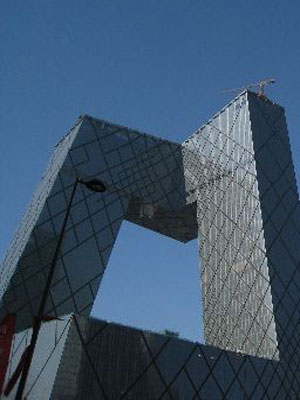By Wu Jin
 The new China Central Television (CCTV) headquarters designed by prominent Dutch architect Rem Koolhaas was intended as a grand landmark to grace the Beijing skyline and inject pride among local residents.
The new China Central Television (CCTV) headquarters designed by prominent Dutch architect Rem Koolhaas was intended as a grand landmark to grace the Beijing skyline and inject pride among local residents.
But the glass-concrete accompanied by an auxiliary skyscraper beside it left Beijingers cold, despite their familiarity with the avant-garde architecture that has sprouted around the ancient capital in recent years. They stare sourly at the geometric giant, feeling mocked by what they saw as obscene symbolism artfully encoded in the design.
The structure attracted a barrage of criticism from netizens, furious at what they saw as sexual undertones of the structures. The criticism finally drew a response from Koolhaas. Last month, his firm's website carried a statement in Chinese apologizing for any offence caused, and denying that the designs contained any hidden erotic meaning.
But critics draw attention to Koolhaas' 2004 book, Content, in which a naked model is shown displaying her buttocks next to the design of the main CCTV building, and another is shown kneeling beside a building that suspiciously resembles the auxiliary high-rise. According to Koolhaas, the pictures were meant as harmless jokes.
Koolhaas' apology seems not to have been accepted. In an August 25 poll conducted by the news website Huanqiu.com, 47 percent said they believed the smutty symbolism was deliberate and were enraged at what they saw as deliberate mockery. The remaining 53 percent were split evenly between the options "It might have been deliberate but it doesn't matter too much" and "I can't believe the accusation is true".
It is hard to believe the architects were totally innocent when they drew up the designs for the CCTV HQ. For one thing there is the evidence provided by the risqué pictures in the 2004 book.
Whatever the truth of the matter, people are beginning to question why there are so few Chinese architects involved in the creation of landmark buildings and why the country seems to rely solely on imported ideas. The National Theater, the Bird's Nest, the Water Cube and Terminal Three of Beijing’s Capital Airport, were all designed by overseas architects.
These views cannot be dismissed as a call for the country to close its doors to outside ideas. China has welcomed foreign architects for centuries and some of its most treasured ancient villas and pagodas were designed by, for example, Italians or Nepalis. But in those days they enhanced rather than overwhelmed the city.
Chinese people are acutely aware of the importance of symbolic buildings, intended to stand for centuries. They understand that such buildings will influence the emotions of the people for generations.
People are a long way from demanding the exclusion of foreign designers from the domestic architectural arena. But there is undoubtedly a growing feeling that buildings should at least look comfortable in Chinese eyes and fit in to some extent with Chinese concepts of aesthetics.
(China.org.cn September 10, 2009)